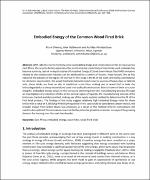| dc.contributor.author | Olweny, Mark R. O. | |
| dc.contributor.author | Ndibwami, Alex | |
| dc.contributor.author | Ahimbisibwe, Achilles | |
| dc.date.accessioned | 2018-04-04T09:27:10Z | |
| dc.date.available | 2018-04-04T09:27:10Z | |
| dc.date.issued | 2017 | |
| dc.identifier.citation | Olweny, M., Ndibwami, A. and Ahimbisibwe, A. 2017. Embodied energy of the common wood fired brick. In Aurel, M. (ed.), back to the future: the 50 years, 51st International conference of the Architectural Science Association (2017, 29 Nov. - 2 Dec), The Architecture Science Association and Victoria University of Wellington, Wellington, New Zealand. | en_US |
| dc.identifier.uri | http://hdl.handle.net/20.500.12280/498 | |
| dc.description.abstract | With calls for environmentally conscious building design and construction on the increase across
East Africa, the need to better appreciate the environmental credentials of commonly used materials has
become a priority.Lack of in‐depth studies of Embodied Energy (EE) and Green House Gas (GHG) emissions
related to the construction industry can be attributed to a variety of factors, most notably, the ad hoc
nature of the industry in the region. Of interest for this study is the EE of the most commonly used material
for domestic construction, the wood fired brick.Manufactured close to sources of heavy clays or laterite
soils, these bricks are fired on site in traditional scove kilns, making use of wood fuel to bake the
bricks.Regarded as a cheap material and used in virtually all construction, little is known of their structural
integrity, embodied energy values or the emissions stemming from the manufacturing process.Through
an investigation of a selection of kilns in the central region of Uganda, the manufacturing process of the
bricks was tracked and documented, making use of the inputs‐outputs method to determine the EE of the
final brick product. The findings of this study suggest relatively high Embodied Energy value for these
bricks with a value of 4.26MJ/kg.While burning wood in this case could be considered carbon neutral, the
broader impact from Green House Gas emissions as a result of this method of brick manufacture still
needs to be explored.This also raises concerns for the potential growth in materials to support the growing
demand for housing over the next few decades. | en_US |
| dc.language.iso | en | en_US |
| dc.publisher | The Architectural Science Association | en_US |
| dc.subject | Fired brick | en_US |
| dc.subject | Embodied energy | en_US |
| dc.title | Embodied energy of the common wood fired brick. | en_US |
| dc.type | Other | en_US |


